Time, Media, & Visuality in Post-Revolutionary France edited by Iris Moon and Richard Taws
Reviewed by Daniella BermanDaniella Berman
Ph.D. Candidate, Institute of Fine Arts, New York University
Institutional Partnerships Manager, Master Drawings New York
Email the author: daniella.berman[at]nyu.edu
Citation: Daniella Berman, book review of Time, Media, & Visuality in Post-Revolutionary France edited by Iris Moon and Richard Taws, Nineteenth-Century Art Worldwide 21, no. 3 (Autumn 2022), https://doi.org/10.29411/ncaw.2022.21.3.13.
This work is licensed under a Creative Commons Attribution-NonCommercial 4.0 International License  unless otherwise noted.
unless otherwise noted.
Your browser will either open the file, download it to a folder, or display a dialog with options.
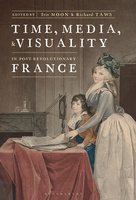
Iris Moon and Richard Taws, eds.,
Time, Media, & Visuality in Post-Revolutionary France.
London: Bloomsbury Visual Arts, 2021.
280 pp.; 32 color & 61 b&w illus.; bibliography; index.
$115.00 (hardback); $103.50 (Ebook)
ISBN: 978–1–5013–4839–6
In his Rapport sur l’État des Beaux-Arts en France of 1808, Joachim Le Breton remarks that 1793 marked a new era, one in which “fears, privations, or misfortunes weighed too heavily on the arts and artists for them to conceive [of] or execute great works, especially those in need of calm and security.”[1] Arguably, Le Breton could be more generous in his assessment: all artistic production would have benefited from calm and security in the wake of the turmoil of the first years of the French Revolution, but that was not, so to speak, in the cards for either the immediate or near future. Indeed, as Time, Media, & Visuality in Post-Revolutionary France demonstrates, the legacy and impact of the early years of the Revolution would be felt throughout the nineteenth century. Edited by Iris Moon and Richard Taws, the volume’s exceptionally strong essays introduce the reader to a breadth of material and visual culture not typically presented together—and often not considered at all—to make the compelling case for close analysis of the ways in which designers and makers navigated the changing stakes of artistic production following the French Revolution. Notably, the contributions speak to one another and the overarching questions are laid out in the introduction in novel ways that lend the publication a coherence rare for such compilations—a model of what good edited volumes can do.
A robust and thoughtful introduction takes as its point of departure a print by J. F. Cazenave after Louis Léopold Boilly’s L’Optique (ca. 1793)—a hand colored version graces the cover—to present the central concerns, tenets, assumptions, and limitations of the volume. Moon and Taws situate their interest in the explosion of artistic adaptation in the aftermath of the Revolution “as artists active in diverse media worked out what it meant to be ‘post-revolutionary’” (3). The emphasis on artists as individuals navigating the turbulent period is most welcome in a field that often fails to give weight to discussions of commodities and the realities of life, as if the negotiation of the lofty ideals of the Revolution was incompatible with—or, worse, somehow eliminated the need for—all practical considerations. One cannot survive on ideals alone, no matter how impassioned. In our own moment, as art institutions—museums and academia alike—are increasingly called upon by artists, cultural workers, and activists, to take the whole person into account and to take stock of very real, basic needs of individuals, this reconstitution of artists as individuals—people and citizens—navigating the realities of the period feels particularly timely.
The editors emphasize the ways in which the events of the Revolution caused a rupture—or, more accurately, many ruptures—in French society, impacting all spheres of artistic production. What goes unexamined are the ways in which the period from 1789 to 1799 was full of shifting political tides that had profound implications for individuals and artistic practice. Committed to exploring “the half century after the storming of the Bastille” (9), the editors do little to address what might be considered the end point of the Revolution and thus the beginning of the post-revolutionary—their subject. If everything after the storming of the Bastille in July of 1789 is post-revolutionary, what is the space held for the Revolution? This is particularly surprising because the introduction does nod to relevant recent scholarship on the complicated notions of time during the Revolution, and doubly so because each editor has thought deeply and intelligently about the ebb and flow of revolutionary politics and the transitional period it represents: Moon in her recently released Luxury After the Terror (2022) and Taws in his important The Politics of the Provisional: Art and Ephemera in Revolutionary France (2013). However, I note that they are not alone in skipping the Revolution to focus on the post-revolutionary; Tom Stammers’ Purchase of the Past: Collecting Culture in Post-Revolutionary Paris c.1790–1890 (2020) is just one recent example that subsumes the period of the Revolution into a discussion of the post-revolutionary. The unfortunate effect of this elision is to reproduce two widespread biases in the fields of nineteenth-century studies and in art history: that of seeing the Revolution as a (complicated) monolith, and of seeing the rupture as the point of origin for the nineteenth century, arising ex nihilo and binding the emergence of modernity to revolutionary political culture. Striving to work against scholarship that “neglects” the connections to “cultural practices of the past” (10), Moon and Taws nevertheless frame this as a thoroughly nineteenth-century story. Many of the thoughtful contributions that follow, however, recuperate the eighteenth-century roots imperative to the consideration of the artists, reputations, institutions, artistic practices, and aesthetics discussed.
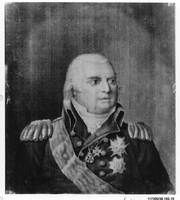
The introduction further discusses the volume’s focus on different types of media and visuality, calling for a “recalibration of the art historical angle of vision” by examining types of artworks typically excluded from “the period’s canon to tell a different history of French art’s modernity” (7). The editors acknowledge the risks both of “a fetishization of marginal outliers” and of replacing “one canon with another, equally arbitrary one” (7). Nevertheless, the volume flirts with precisely these conceits; the editors’ assertion that “the boundaries between non-elite and elite forms of artistic practice, as well as between institutionally lauded artists and jobbing hacks, were very fine and often breached” (7–8), would have been perhaps well served by thinking about crosspollination across media and collaboration among artists and with artisans, as suggested by the passing mention of a portrait of Louis XVIII by Gaspard Grégoire on velvet after a portrait by François Gérard or Jacques-Louis David (early nineteenth century, fig. 1). Such instances would bring “elite” and “non-elite” art forms into dialogue and shed light on the way the respective artists interacted, collaborated, and coexisted, navigating the period alongside one another.
In some ways, the proposition is self-defeating: by excising discussion of “grand manner painting and sculpture” (9), the volume creates a parallel rather than integrated discourse. This reviewer wonders (admittedly in self-serving terms, having recently contributed to The Metropolitan Museum of Art’s 2022 exhibition Jacques Louis David: Radical Draftsman), whether it is really necessary to eschew all discussion of David and his students in order to tell a more nuanced story of art making during and after the Revolution. The editors, too, seem to sense this tension, conceding that “neither ‘major’ or ‘minor’ arts could exist without the other as a foil. Shaping the path the other has taken, they have determined how their reciprocal stories are told” (22). The volume’s great contribution is in tracing examples of those various paths that expand the ways readers think about material culture, artistic practice, and what it meant to be both an artist and post-revolutionary. In so doing, it demonstrates how ways of seeing were socially constructed and conditioned, not just by the period’s myriad demands on the viewer and the artist, but equally by the interpretation and re-interpretation of the Revolution throughout the nineteenth century.
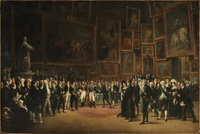
The essays in this remarkably balanced and well-written publication are captivating, rigorous, engaging, and cover an impressive amount of material, serving both to introduce their particular contexts and media, and to make compelling arguments rarely possible in the circumscribed page count of an edited volume. These contributions expand our understanding of established works such as François-Joseph Heim’s Charles X Distributing Prizes (1827, fig. 2) with fresh perspectives and new ideas that simultaneously complicate the larger problematics posed by the editors and breathe new life into our understanding of the period. The texts consider a variety of figures, from the very familiar put to new ends or in unfamiliar contexts—Boilly (Moon and Taws, and Matlock), Jean-Baptiste Isabey (Matlock and Moon), Charles Percier and Pierre-François-Léonard Fontaine (Moon), and Jean-Baptiste Huet (Hornstein)—to the little known or almost forgotten—Victoire Jaquotot (Harkett), Charles Philipon (Siegfried), and Georges Michel (Taws)—to the unknown and anonymous painters, caricaturists, printmakers, and artisans that populated the same world as the named protagonists and struggled just as much to navigate artistic practice and identity in the wake of the Revolution.
What the contributors do exceptionally well is to complicate our notion not only of the problematics of artistic production during and after the Revolution, responding to well-known and oft-discussed developments such as the closing of the Royal Academy of Painting and Sculpture and the democratization of the Salon, but also in understanding shifting trends and currents not as happenstance occurrences, but as deliberate, thoughtful efforts of adaptability on the part of the numerous artists striving to maintain their practice. Jann Matlock’s essay, “Miniature Style, 1789–1815,” opens the discourse around the genre of miniature portraits of unidentified figures by unknown hands. This essay explores how miniatures often served as the artist Jean-Baptiste Isabey’s notion of portraits de consolation, portraits to comfort those left behind during the Revolution.[2] Matlock emphasizes certain types of spectatorship and commodification to explore how the medium “worked,” and when it did not. Building on the important work of identifying subjects and artists that so often preoccupies scholarship on miniatures, Matlock pushes us to think about stylistic questions more broadly, aking “even detached from their sitters and owners, what values do they still relay?” (30). In this, Matlock’s text serves as a useful model for considering portraiture—regardless of size and scale—of unidentified sitters and thinking about how, even absent such information, a work of art nevertheless bears witness to the period and circumstances of its creation.
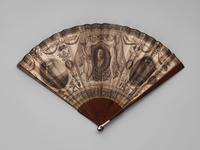
In “Rupture, Interrupted: Rococo Recursions and Political Futures in Percier and Fontaine’s Napoleon Fan,” Moon likewise considers questions of circulation and versatility. Moon stresses the experimental nature of many of the works focusing on a remarkable fan celebrating Napoleon Bonaparte designed by architects Charles Percier (1764–1838) and Pierre-François-Léonard Fontaine (1762–1853) and the sculptor Antoine-Denis Chaudet (1763–1810) (fig. 3). Characteristically, Moon pays careful attention to the materiality and make of fans, allowing the reader to better understand where and how artists and artisans intersected and collaborated on such projects. Filled with rich observations and thoughtful asides that one hopes will be meaningfully expanded elsewhere, this essay offers a fascinating exploration of the ways in which material culture can reflect the period’s tensions between public and private, and between the fleetingness of fashion and the (aspiration of the) longue durée of history.
If Moon considers an example of artistic adaptability that was somewhat of an anomaly for the architects Percier and Fontaine, then Stephen Bann’s contribution delves deeply into the shifts in the career and life of one artist. In “A Draughtsman’s Contract: Court and Country in the Work of Louis Lafitte,” Bann beautifully lays out a dynamic interplay of eighteenth-century and post-revolutionary artistic values and concerns at play not just for Louis Lafitte (1770–1828), but also in the overall culture of visuality. Bann explores the ways in which Lafitte’s scope of activities broadened following the Revolution to present readers with a wider view on the arts in early nineteenth-century Paris. In so doing, this essay points to nineteenth-century forms of spectacle—transparencies, panoramas, etc.—that did not make it into the volume. Bann, more explicitly than other contributors, engages with T. J. Clark’s assertions that the flag of modernity ought to be planted somewhere amidst the tumult of the Revolution.[3] Situating Lafitte within the broader institutional and cultural shifts that profoundly impacted his life, Bann concludes by asserting Lafitte’s unexceptional status—that “as in others, Lafitte’s legacy proved to be a causality of his times” (99).
Unlike Lafitte, who was only 29 when the Bastille fell, Jean-Baptiste Huet I (1745–1811) had had a full, successful career under the ancien régime. In “Jean-Baptiste Huet’s Lions and the Look of the Captive in Post-Revolutionary France,” Katie Hornstein explores the cultural contexts and political implications of Huet’s portrait of a family of lions in the Jardin des Plantes. In this smart text that whets the appetite for the larger project, Hornstein pays close attention to the size, scale, and composition of this work, now in a private collection, to understand it as an outlier—within Huet’s oeuvre and the surviving contemporary corpus. Situating the leonine portrait within the shifting (or collapsing) hierarchy of genres, this essay explores the possibilities and limitations of the categories of history and genre painting. In tracing contemporary discourses about the civilizing power of socialization for these lions, Hornstein reveals the way that “unbridled animal ferocity became one of the most powerful rhetorical tools available for disavowing the humanity of the perpetrators of political violence across the political spectrum before, during, and after the Revolution” (105). Like other essays in the volume, Hornstein’s exploration emphasizes the malleability of meaning of many artworks, concluding of Huet’s lions that “one of this painting’s political meanings is its ability to give us a mirror into the shifting nature of post-revolutionary political vicissitudes, to which all parties might potentially fall prey, both as perpetrators and as fearful victims” (119).
In “First as Farce, then as Tragedy: Art, Vaudeville, and Modern Painting after the French Revolution,” Steven Adams discusses the representation of artists in print and on stage, focusing on the popular comedic form of vaudevilles. Tracing the form’s relationships to commedia dell’arte and popular forms of entertainment of the eighteenth century, this essay is concerned with the impact of such portrayals in various vaudevilles on the idea of the artist. Particularly, Adams emphasizes the “changing conception of a profession” and notes with the shift from “networks of filiations—the breaks, discontinuities, and continuities—that constitute the history of late eighteenth and early nineteenth-century French art” to the “march towards art’s autonomy described by late-nineteenth- and twentieth-century critics” (125). In so doing, Adams expands the framework of the volume to explicitly consider how the period in question was constructed by contemporary and later critics.
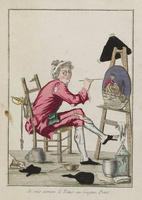
Kathryn Desplanque also explores the status of the artist, but through close attention to satirical images of the shop sign painter. In “Monsieur Crouton, The Shop Sign Painter: The Unexceptional Artist in Early Nineteenth-Century Satirical Print,” Desplanque recounts the history of elite artists painting shop signs, beginning with the best-known example by Jean-Antoine Watteau (1684–1721) for the dealer Edmé-François Gersaint (1720), to understand the emergence of the trope of a sign painter, Monsieur Crouton, prominent in vaudevilles and satirical prints such as one entitled “Je suis comme le Tems au Gagne Petit” (1789, fig. 4). Desplanque’s compelling text investigates how this type of artistic production was understood by artists, institutions, and the public in the post-revolutionary period and, in turn, impacted the artist’s social status. As Desplanque contends, in the post-revolutionary context,
. . . this satirical trope was applied in several ways, vacillating between sympathy for the artist forced to debase his work for profit and outrage at an art world that could not adequately support him, coupled with paranoia that the illiterate masses have rushed the gates of the fine arts, clamoring for their undeserved membership (161–62).
Integrating analysis of little-known but seemingly familiar satirical prints with important structural changes to the Parisian art world that deeply impacted the work of artists and the implications of their labor, this essay sheds light on a fundamental tension that artists experienced between “their former status of distinction” and their “newfound freedom to practice and participate in an open art market” (162).
In “Medium as Museum: Marie-Victoire Jaquotot’s Porcelain Painting and Post-Revolutionary Fantasies of Preservation,” Daniel Harkett offers a thought-provoking introduction to an often-overlooked initiative of the early nineteenth century and its cunning champion. Victoire Jaquotot (1772–1855) produced reproductive paintings of the Western canon on porcelain. Hackett traces the implications of the medium, a symbol of French ingenuity intimately tied to “the perceived cultural achievements of past kings,” and the discourses around the porcelain paintings’ stability despite, paradoxically, the support’s inherent fragility. This tension between stability (of coloristic effects, as juxtaposed with damaged paintings) and fragility mirror the political contexts of that moment; the monarchy’s perceived invulnerability had, of course, been shattered by the Revolution. Hackett demonstrates the ways in which the restored Bourbon monarchy deployed attention to the arts and the canon for political ends at the very moment that the Louvre was being dismembered for forced restitution of artworks to Italy, writing “projecting care for the arts opened up fertile metaphorical ground that the new regime could use to cultivate an image of solicitous benevolence in the new era of constitutional monarchy” (170). Rhetoric around the initiative emphasized transmission to posterity, made possible by the medium’s endurance that, in turn, carried the name of the Bourbon king to the “most distant centuries,” as noted in 1825 by Auguste Forbin, director of the royal museums (171). In this, Hackett argues for the parallels between the medium and the utopian space of the museum, both of which carry the “cultural assumptions of their own time” (177), drawing on Hubert Robert’s Project for the Transformation of the Grande Galerie of the Louvre (1796) in this discussion. This rich essay considers Jaquotot’s artistic practice, particularly its recuperative impetus, alongside her administrative prowess circumventing the bureaucracies that otherwise ruled the art world to secure access and compensation, and the tensions and complexities that the porcelain painting museum project encapsulates and exposes.
Although other contributions touch on the importance of sartorial tastes and changeability in the post-revolutionary moment, the relationship of fashion to politics is in the forefront of Susan L. Siegfried’s essay, “The Cultural Politics of Fashion and the French Revolution of 1830.” Siegfried discusses the potential connotations of both the “recollection” of the fashions of “the great Revolution” (195) and the absence of fashion trends. In exploring the way in which the citizen king Louis-Philippe styled himself, Siegfried expands our understanding of how fashion can serve as a form of political commentary and how, in turn, notions of the juste milieu beyond the arts—as “an equal distance from the excesses of popular power and the abuses of royal power”[4]—permeated fashion. The printmaker, publisher, and caricaturist Charles Philipon (1806–62), who “turned fashion and costume into a political discourse,” (202) emerges as the protagonist of Siegfried’s narrative. Siegfried looks closely at both Philipon’s fashion lithographs and satirical images that often circulated together to uncover the way sartorial choices could be used as political commentary, beyond the dichotomy of revolutionary or royalist, to understand and communicate France’s colonial ambitions and attitudes.
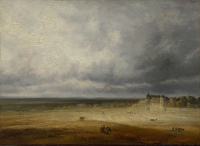
In the volume’s final essay, “A Storm is Coming: Georges Michel in the Wind,” Taws discusses both the oeuvre of Georges Michel (1763–1843) and the revival of the artist’s reputation by the dealer and critic Alfred Sensier (1815–77) in the last quarter of the nineteenth century.[5] Taws examines Michel’s moody landscapes (for example, fig. 5) to reveal how the artist’s work “spoke—often in oblique ways—to new perceptions of post-revolutionary France’s place in history, and to the by turns visible and invisible methods used to calibrate this” (224). The essay explores contemporary discourses on the environment, the new (visual) prominence afforded to new technologies (particularly the optical telegraph), the transformation of the urban fabric (especially Montmartre), and the social and cultural upheavals that impacted Michel’s life and art, as well as Sensier’s interest in him several decades later. Taws utilizes this case study to bring forth the reciprocal ways in which shifts in later nineteenth-century reception of the revolutionary period in turn inflected perception of what it meant to be post-revolutionary and when the notion ceased to be relevant. Sensier’s focus on Michel’s “unfashionability” and “the recoding of his untimeliness as timelessness” were at odds with what little is known about the artist’s engagement with revolutionary politics and the myriad ways in which time was embedded in his work and subjects (237). Taws therefore suggests that scholars should interrogate not just how, but also why and when artists working through the revolutionary era were recuperated and resuscitated by nineteenth-century historians, dealers, and collectors to reveal how histories (national, personal, and familial) inflect interpretation of earlier artists’ politics and impact the writing and rewriting of history.
Having traversed the nineteenth century across the nine exciting contributions, the reader is left to ponder the interconnectedness of the case studies presented and the questions they raise, individually and as a group. Indeed, as Lynn Hunt writes in one of the promotional blurbs for the publication, the whole is greater than the sum of its parts. Taken together, the volume offers not just an introduction to new forms of visuality but new methodological approaches to integrate into our study of this period and beyond.
Finally, it is profoundly unoriginal to lament the limited number of illustrations included. We are all aware of how challenging it can be to beg publishers for an adequate image count, let alone in color. However, in a volume that addresses the subject of visuality, the question of images seems particularly important and, thus, the reality especially disappointing. In some cases, the thirty-one color plates and handful of black-and-white illustrations in each essay suffice, but in many other instances the reader would benefit from having the artwork under discussion reproduced. The work-around of citing publications that reproduce the relevant artwork is disruptive, requiring one to pull various, sometimes obscure catalogues (and in a few cases, errors in the page numbers given in references lead the curious-qua-obsessive reader on a wild goose chase). One therefore especially appreciates the instances where thoughtful details are included that allow readers to follow the visual argument being made with great precision. As contributors and editors, we make do with what we are allotted in terms of image quotas, but one still laments the prohibitive costs that make the inclusion of illustrations, and especially color illustrations, so inaccessible, and the price of a volume with a limited illustration program so high.
Notes
[1] “Les craintes, les privations ou des malheurs pesaient trop sur les arts et les artistes, pour qu’ils eussent pu concevoir et exécuter de grands ouvrages, sur-tout de ceux qui ont besoin de calme et de sécurité.” Joachim Le Breton, “Rapport sur les beaux-arts en France” (1808) as published in Jean-Baptiste Delambre, ed., Rapports à l’Empereur sur le progrès des sciences, des lettres et des arts depuis 1789, vol. 1 (Paris: Belin, 1989), 52.
[2] In this, Matlock builds on recent scholarship by Sophie Matthiesson, “The Prison-made Object in the French Revolution” (PhD diss., Monash University, 2016).
[3] T. J. Clark, “Painting in the Year Two,” Representations, no. 47, Special Issue: National Cultures before Nationalism (Summer 1994): 13–63.
[4] Louis-Philippe’s formulation as quoted in Guy Antonetti, Louis-Philippe (Paris: Fayard, 1994), 713.
[5] Interest in Michel has been renewed thanks in part to the 2018 exhibition at the Fondation Custodia that focused, however, on the connections to the Dutch landscape tradition: “Georges Michel: The Sublime Landscape,” Fondation Custodia-Collection Frits Lugt, Paris (January 27–April 29, 2018). The exhibition website remains a useful resource for those interested in the artist, https://www.fondationcustodia.fr/Georges-Michel-57.